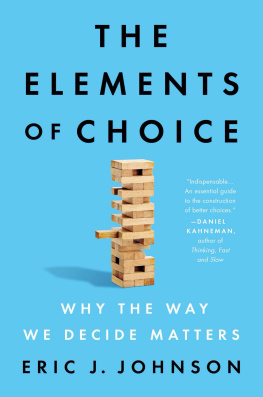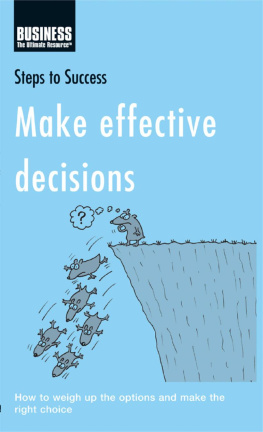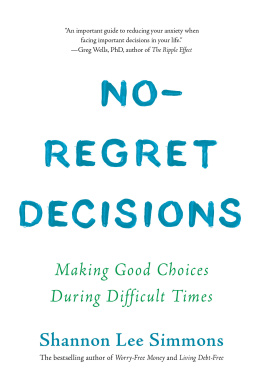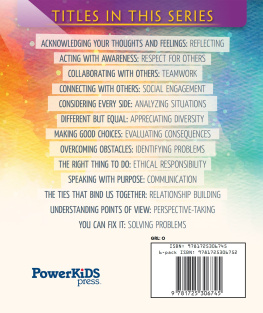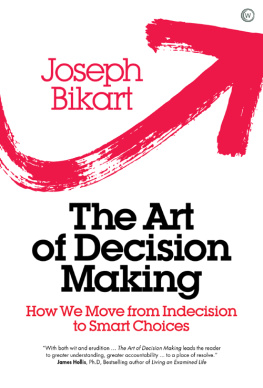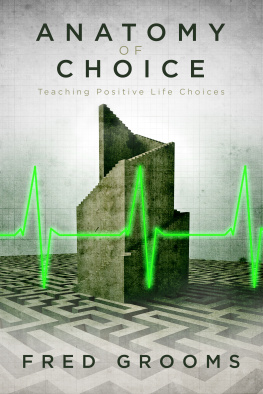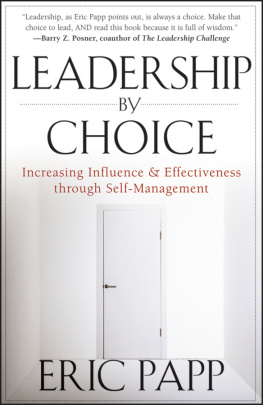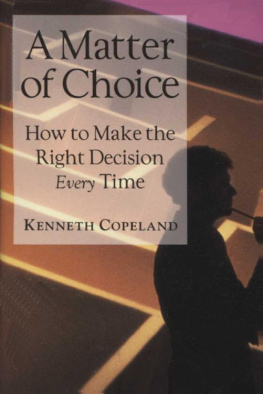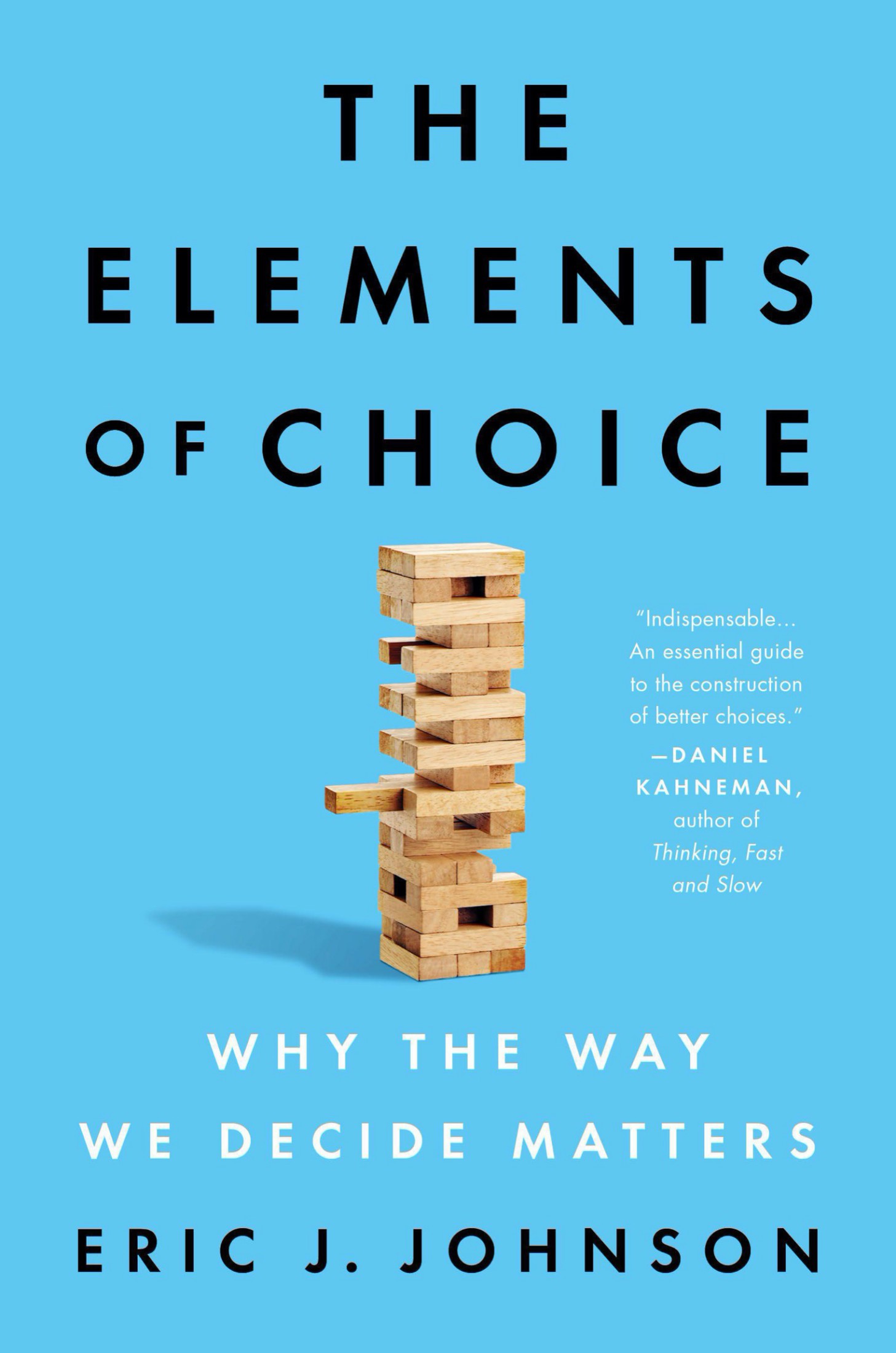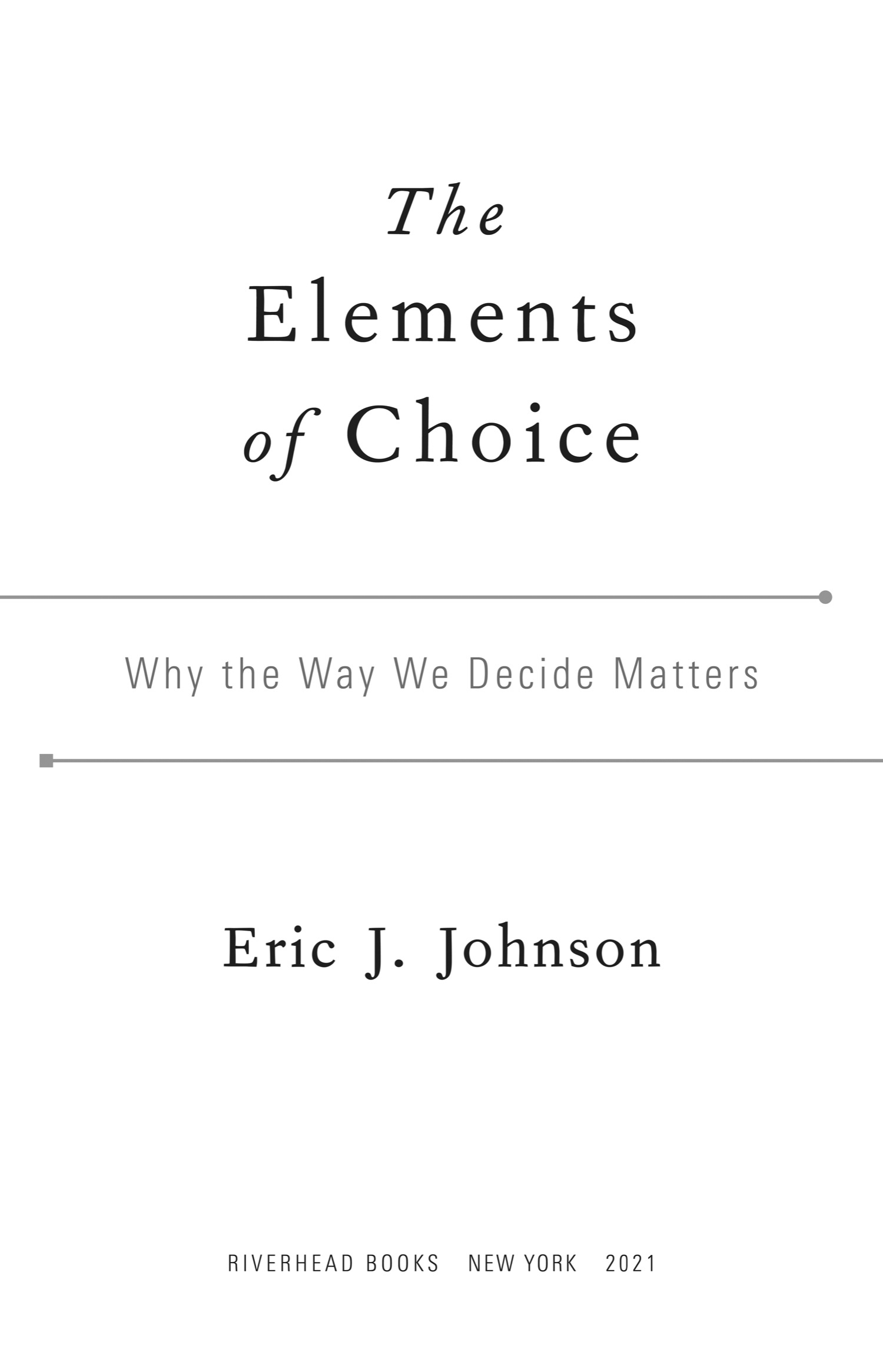
Riverhead Books
An imprint of Penguin Random House LLC
penguinrandomhouse.com

Copyright 2021 by Eric J. Johnson
Penguin supports copyright. Copyright fuels creativity, encourages diverse voices, promotes free speech, and creates a vibrant culture. Thank you for buying an authorized edition of this book and for complying with copyright laws by not reproducing, scanning, or distributing any part of it in any form without permission. You are supporting writers and allowing Penguin to continue to publish books for every reader.
Riverhead and the R colophon are registered trademarks of Penguin Random House LLC.
Library of Congress Cataloging-in-Publication Data
Names: Johnson, Eric J., author.
Title: The elements of choice: why the way we decide matters / Eric J. Johnson.
Description: New York : Riverhead Books, an imprint of Penguin Random House LLC, 2021. | Includes bibliographical references and index.
Identifiers: LCCN 2021015312 (print) | LCCN 2021015313 (ebook) | ISBN 9780593084434 (hardcover) | ISBN 9780593084458 (ebook)
Subjects: LCSH: Decision making.
Classification: LCC BF448 .J638 2021 (print) | LCC BF448 (ebook) | DDC 153.8/3dc23
LC record available at https://lccn.loc.gov/2021015312
LC ebook record available at https://lccn.loc.gov/2021015313
International edition ISBN: 9780593421215
Cover design: Vi-An Nguyen
Cover image: SomchaiP / Shutterstock
Book design by Alexis Farabaugh, adapted for ebook by Maggie Hunt
pid_prh_5.8.0_c0_r0
To Elke Weber, my family, and all designers, now and in the future
Contents
1
Shaping Choices
It is an illusion, really, that we alone determine what we choose. You walk into a restaurant and order a sandwich. Your spouse asks you what movie you want to see. Your doctor asks if you want to try a new drug to control your cholesterol. You search for a flight home for the holidays. You select an investment fund from your employers retirement plan. You may not realize it, but in each choice, you have a hidden partner.
You choose something, but the restaurant, your spouse, the doctor, the airlines website, and your employer have all made decisions about how to pose those choices to you. Their design decisions will influence, intentionally or not, what you choose. The restaurant organized the sandwich options you saw, maybe with vegetarian on the right, meat on the left. Your spouse suggested some possible movies, but left others out. The doctor decided how to describe the consequences, side effects, and benefits of the drugs you could take to control your cholesterol. The website decided how to sort the flights and whether to present certain pieces of information, like the on-time performance of the flights and the baggage fees. And finally, your employer had a fund it would use for your retirement account if you did not make a choice.
We might vaguely agree that external factors influence our choices, but we dont appreciate that there are large and systematic ways in which presentation can change what we choose. Years of research have shown again and again that the way choices are posed affects our actions. Were much more likely to choose a retirement fund if the employers website preselects that option for us. We make different choices if our doctor says that serious side effects occur in 1 percent of cases, as opposed to saying there are no side effects in 99 percent of cases. And while you might be convinced that you are picking the sandwich, many things about the menu, like the order of items and the headings of the categories, helped you make that choice.
All these details are part of something called choice architecture, the many aspects of how a choice is posed that can be manipulated, intentionally or inadvertently, to influence the decisions we make. The options may be the same, but the presentation can change your choice.
Before you make a decision, someone has molded many of the characteristics of that choice for you, and these design decisions will in some way affect what you choose. This book takes a close look at exactly how the way choices are presented can change the decision-making process. Whether they realize it or not, the people who present those choicesthe restaurant owner, your spouse, your doctor, your employerare choice architects. Stated more simply, choice architects are the designers of the decisions you make, just as you are the designer of countless choices for others and for yourself. To keep things simple, I will call the choice architects designers and the people making decisions choosers.
Choice architecture can be harnessed in surprising and surprisingly powerful ways, with positive results for both the designer and the chooser. But to do so, we must look closely at every detail of a choices design, including elements we dont normally notice. After all, when we encounter a choice, we are too busy making the choice to contemplate how the presentation of options affects us. But get those details right, and better decisions can emerge.
I became interested in decision-making and decision design as I contemplated college. Coming from a working-class, Levittown-like suburb in New Jersey, it struck me that many of my friends from high school were considering very different options for their lives. In my high school, there were many academically talented students, but some were delighted to go to the local community college, and others, equally qualified, were applying to Ivy League schools. What made them consider different options? I saw, in the years that followed, that the choice of what to consider in large part determined their future.
Being lucky (and foolish) enough to talk my way into places where pathbreaking work in decision-making was done, I found myself in graduate school at Carnegie Mellon, and a postdoc at Stanford, places central to the beginning of a revolution in decision research and behavioral economics. This revolution was based on the idea that people use simplified rules of thumb, or heuristics, to make decisions. The classic demonstration involved people making inconsistent choices, caused by things that should not matter. Describing the same options as gains or losses can change choices. Telling people about irrelevant numbers can change how much they are willing to pay. People are much more willing to pay for insurance against a vivid risk, like cancer, than they are willing to pay for insurance that covers all diseases. There was soon a list of these effects, which was sometimes called stupid human tricks, after David Lettermans comedy bits.
These results were usually cast as showing how people are irrational and generally bad at making decisions. I had always been interested in public policy and improving decisions, and I realized that we could flip that framing for positive ends: instead of exposing people as bad decision-makers by showing they were inconsistent, maybe we could make them better decision-makers by exploiting these inconsistencies. By changing how their choices were posed, we might help them make better decisions.

